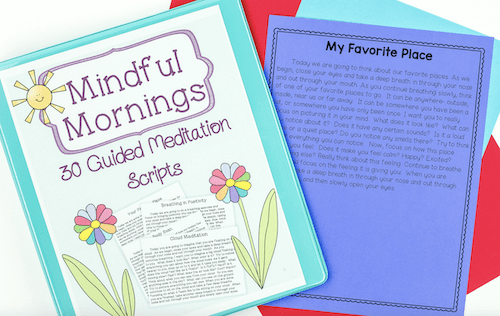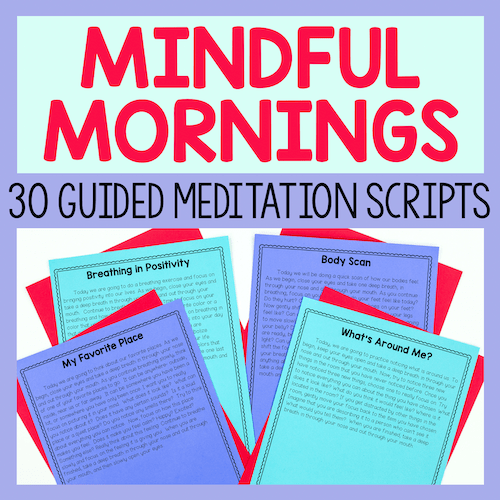How To Use Mindfulness To Decrease Student Anxiety
Childhood anxiety is a problem. According to the CDC, over 7% of children have diagnosed anxiety - that’s nearly 4.4 MILLION children, and that number doesn’t include students who have not been formally diagnosed. I know from firsthand experience how crippling anxiety can be. Whether it’s fear of rejection, weather, violence, etc., anxiety can leave kids (and adults) feeling distracted, unmotivated and even panicked. While those feelings can certainly be overwhelming, studies have shown that one way that students can reduce their feelings of anxiety and begin to feel more relaxed is by practicing mindfulness. By using mindfulness with anxious students, you can give them the tools they need to feel calm and focused.
Mindfulness is the practice of noticing our thoughts and feelings in the present moment. The great thing about using mindfulness to support students with anxiety is that it can be implemented in simple yet impactful ways. Keep reading to learn my favorite mindfulness strategies that you can begin using with your anxious students today!
1. Grounding Exercises
One mindfulness practice that can be helpful to use with anxious students is grounding. Grounding is the act of bringing our attention to the present moment. This is the perfect antidote to anxiety, which occurs when our thoughts get stuck in the past or the future. A great grounding exercise to do with students is to encourage them to observe the things around them. First, they will notice 5 things they can see, then 4 things they can feel, then 3 things they can hear, then 2 things they can smell and finally, 1 thing they can taste.
Grounding is a great strategy to use with students who are facing anxiety. It can be helpful in many situations that kids face like taking a test, entering the classroom, or giving a presentation. You can also use this exercise with all students at the beginning of the school day or class period to help them feel focused and in the present moment.
For some students, it is even more helpful for them to write down what they are experiencing in the current moment. Click below to sign up for my weekly e-mail list and receive a free mindfulness worksheet focused on grounding.
2. Use Mindfulness Scripts For Students With Test Anxiety
Leading students through mindfulness scripts before tests is a great way to help your anxious students feel calm and ready to do their best. The 10-40% of students who have test anxiety freeze when it’s time to begin, even though they have done enough to prepare. By guiding students through short mindfulness scripts, you can help your anxious students feel focused as they show off the skills they have learned. For students I have worked with, I have used the guided meditations pictured below. They include 30 scripts to help students practice mindfulness techniques such as deep breathing, awareness of thoughts and surroundings, and guided imagery.
3. Teach Mindful Mantras
Mindful mantras are statements that we can repeat over and over to help us stay focused on what is true about the present moment. Teaching students to use mindful mantras such as “I am safe,” “I am in control,” or “I am here,” can help them counter their anxiety. You can work with anxious students individually to develop their own mindful mantras, or choose some as a class or group to repeat together. By teaching students to use mindful mantras, you will give them a coping strategy they can use any time their feelings of worry and anxiety begin to grow.
4. Display Visuals Around The School To Encourage Mindfulness
By displaying visual supports focused on mindfulness and anxiety, students will be more familiar with what they are feeling and how to handle it. Unfortunately, not all anxious kids will tell someone, or be able to articulate, the feelings they are experiencing. However, when they are exposed to information and strategies related to anxiety and mindfulness, they will have a better understanding of their feelings and will feel more comfortable talking about it with others. Examples of displays include mindful breathing posters (pictured below), informational posters about anxiety, etc. Displaying visuals ensures that even students who don’t seem receptive to your mindfulness lessons and activities will be able to access helpful information.
5. Include Mindfulness Materials In Your Calm Down Area
Thankfully, many educators are beginning to create spaces where students can go to calm down. These are usually quiet areas for the student to regulate themselves and become re-focused. If you have a space like this in your classroom or office, make sure it includes materials that will help students practice mindfulness. To encourage deep breathing, consider adding pinwheels or even a Hoberman sphere. Paper or blank journals will give students the opportunity to process their feelings of anxiety through journaling or drawing. Adding materials that promote mindfulness to your calm down area is a great way to help your anxious students refocus themselves in the present moment.
6. Encourage Students To Do One Task At A Time
Another way to encourage mindfulness with anxious students is allowing them to focus on one task at a time. When giving out work assignments or instructions, allow the student to complete the first step before giving the next direction. Not only will these keep your students from becoming overwhelmed, but it also allows students to fully focus on what they are doing instead of being anxious about what is to come.
These 6 quick mindfulness tips for your anxious students are easy to implement, but will help your students feel calm, focused and ready to do their best. Don’t forget to sign up below to get added to my weekly e-mail list and receive your free mindfulness worksheet that is perfect for helping students with anxiety stay grounded in the present moment!









